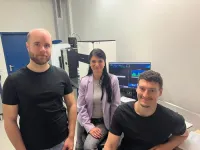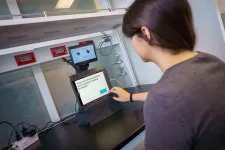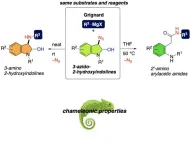(Press-News.org)
Image generator models – systems that produce new images based on textual descriptions – have become a common and well-known phenomenon in the past year. Their continuous improvement, largely relying on developments in the field of artificial intelligence, makes them an important resource in various fields.
To achieve good results, these models are trained on vast amounts of image-text pairs – for example, matching the text "picture of a dog" to a picture of a dog, repeated millions of times. Through this training, the model learns to generate original images of dogs.
However, as noted by Hadas Orgad, a doctoral student from the Henry and Marilyn Taub Faculty of Computer Science, and Bahjat Kawar a graduate of the same Faculty, "since these models are trained on a lot of data from the real world, they acquire and internalize assumptions about the world during the training process. Some of these assumptions are useful, for example, ‘the sky is blue,’ and they allow us to obtain beautiful images even with short and simple descriptions. On the other hand, the model also encodes incorrect or irrelevant assumptions about the world, as well as societal biases. For example, if we ask Stable Diffusion (a very popular image generator) for a picture of a CEO, we will only get pictures of women in 4% of cases."
Another problem these models face is the significant number of changes occurring in the world around us. The models cannot adapt to the changes after the training process. As Dana Arad, also a doctoral student at the Taub Faculty of Computer Science, explains, "during their training process, models also learn a lot of factual knowledge about the world. For example, models learn the identities of heads of state, presidents, and even actors who portrayed popular characters in TV series. Such models are no longer updated after their training process, so if we ask a model today to generate a picture of the President of the United States, we might still reasonably receive a picture of Donald Trump, who of course has not been the president in recent years. We wanted to develop an efficient way to update the information without relying on expensive actions."
The "traditional" solution to these problems is constant data correction by the user, retraining, or fine-tuning. However, these fixes incur high costs financially, in terms of workload, in terms of result quality, and in environmental aspects (due to the longer operation of computer servers). Additionally, implementing these methods does not guarantee control over unwanted assumptions or new assumptions that may arise. "Therefore," they explain, "we would like a precise method to control the assumptions that the model encodes.”
The methods developed by the doctoral students under the guidance of Dr. Yonatan Belinkov address this need. The first method, developed by Orgad and Kawar and called TIME (Text-to-Image Model Editing), allows for the quick and efficient correction of biases and assumptions. The reason for this is that the correction does not require fine-tuning, retraining, or changing the language model and altering the text interpretation tools, but only a partial re-editing of around 1.95% of the model's parameters. Moreover, the same editing process is performed in less than a second. In ongoing research based on TIME, called UCE, which has been developed in collaboration with Northeastern and MIT universities, they proposed a way to control a variety of undesirable ethical behaviors of the model - such as copyright infringement or social biases – by removing unwanted associations from the model such as offensive content or artistic styles of different artists.
Another method, developed subsequently by Arad and Orgad, is called ReFACT. It offers a different algorithm for parameter editing and achieves more precise results. ReFACT edits an even smaller percentage of the model's parameters – only 0.25% – and manages to perform a wider variety of edits, even in cases where previous methods failed. It does so while maintaining the quality of the images and the facts and assumptions of the model that we want to preserve.
The methods receive inputs from the user regarding a fact or assumption they want to edit. For example, in cases of implicit assumptions, the method receives a "source" on which the model bases implicit assumptions (e.g., "red roses" by default the model assumes red roses) and a "target" that describes the same circumstances but with the desired features (e.g., "blue roses"). When wanting to use the method for role editing, the method receives an editing request (e.g., "President of the United States") and then a "source" and "target" ("Donald Trump" and "Joe Biden," respectively). The researchers collected about 200 works and assumptions on which they tested the editing methods and showed that these are efficient methods for updating information and correcting biases.
TIME was presented in October 2023 at the ICCV conference, one of the important conferences in the field of computer vision and machine learning. UCE was recently presented at the WACV conference. ReFACT was presented in Mexico at the NAACL conference, one of the leading conferences in natural language processing research.
The research was supported by the Israel Science Foundation (ISF), the Azrieli Foundation, Open Philanthropy, FTX Future Fund, the Crown Family Foundation, and the Council for Higher Education. Hadas Orgad is an Apple AI doctoral fellow.
END
The function of non-coding RNA in the cell has long been a mystery to researchers. Unlike coding RNA, non-coding RNA does not produce proteins – yet it exists in large quantities. A research team from the University of Göttingen has now discovered an important function of antisense RNA (asRNA): the researchers found that asRNA acts as a "superhighway" in cell transport and thus accelerates gene expression. The results were published in Nature.
RNA (ribonucleic acid) plays a central role in the translation of DNA information into proteins. There are different types of RNA, one of which is known as messenger ...
Video: https://youtu.be/bGKA32TlVXM?si=0PdhaUyOKH33DFbB
Meet CARMEN, short for Cognitively Assistive Robot for Motivation and Neurorehabilitation–a small, tabletop robot designed to help people with mild cognitive impairment (MCI) learn skills to improve memory, attention, and executive functioning at home.
Unlike other robots in this space, CARMEN was developed by the research team at the University of California San Diego in collaboration with clinicians, people with MCI, and their care partners. To the best of the researchers’ knowledge, CARMEN is also the only robot that teaches compensatory cognitive strategies to help improve memory and executive function.
“We ...
New York University has established the Center for Mind, Ethics, and Policy, which aims to further our understanding of the sentience and moral status of nonhumans, notably animals and AI systems.
“The world contains quintillions of animals, and in the future, it could contain an even larger number of AI systems,” says Jeff Sebo, CMEP’s founding director and a professor in NYU’s Department of Environmental Studies. “Human activity is increasingly shaping the lives of these beings, and these trends raise important and difficult questions, such as: Which of these beings are sentient, ...
Whether it’s physical phenomena, share prices or climate models – many dynamic processes in our world can be described mathematically with the aid of partial differential equations. Thanks to stochastics – an area of mathematics which deals with probabilities – this is even possible when randomness plays a role in these processes. Something researchers have been working on for some decades now are so-called stochastic partial differential equations. Working together with other researchers, Dr. Markus Tempelmayr ...
CLEVELAND—With a new five-year, $2.78 million grant from the National Institutes of Health and National Cancer Institute, researchers at Case Western Reserve University(CWRU), Cleveland Clinic and University Hospitals (UH) will use artificial intelligence (AI) to better treat rectal cancer patients.
The American Cancer Society estimates about 46,000 people nationally will be diagnosed this year with rectal cancer—the third most common type of cancer in the digestive system, after colon and pancreatic cancer.
By using AI, the researchers intend to derive specific metrics on magnetic resonance imaging (MRI) scans to better understand how ...
Terahertz technology could help us meet the ever-increasing demand for faster data transfer rates. However, the down-conversion of a terahertz signal to arbitrary lower frequencies is difficult. In a recent study, researchers from Japan have developed a new strategy to up- and down-convert a terahertz signal in a waveguide by dynamically modifying its conductivity using light, creating a temporal boundary. Their findings could pave the way to faster and more efficient optoelectronics and enhanced telecommunications.
As we plunge deeper into the Information Age, the demand for faster data transmission keeps soaring, accentuated by fast progress in fields like deep learning ...
CHAMPAIGN, Ill. — Scientists have identified a potential driver of aggressive lung cancer tumors in patients who live in areas with high levels of violent crime. Their study found that stress responses differ between those living in neighborhoods with higher and lower levels of violent crime, and between cancerous and healthy tissues in the same individuals.
The findings are detailed in the journal Cancer Research Communications.
The study was designed to address the higher incidence of lung cancer in Black men than in white men, said University of Illinois Urbana-Champaign ...
PHILADELPHIA, June 24, 2024 — About 80% of an individual’s modifiable health contributors are determined by social and economic factors.[1] Exposure to violence can have detrimental health implications contributing to toxic stress and trauma, mental health illness, substance abuse and an increased risk for heart disease[2].
The American Heart Association, which marked 100 years of service saving lives earlier this month, has distributed $480,000 from the Association’s Bernard J. Tyson Impact Fund to four social ...
Aniline or nitrogen-containing organic molecules like 3-aniline-substituted indoles commonly found in natural products have shown promising results as pharmaceutical contenders. The same goes for moieties such as 2-aminoaryl acetic acid scaffold which forms the fundamental structural motif of nonsteroidal anti-inflammatory drugs such as diclofenac which inhibits COX-2 to relieve pain and inflammation. While there are several ways of synthesizing these molecules individually using different starting materials, can we produce them ...
It’s summer and time to enjoy the sunshine. But it’s also important to do so safely. Skin cancer is the most common form of cancer in the United States—and it’s most commonly caused by sun exposure. Research has shown that skin self-awareness and regular skin self-examinations are strongly linked to better treatment outcomes if you receive a skin cancer diagnosis.
As part of an effort to identify effective interventions to increase skin self-examinations and decrease melanoma deaths, faculty ...






